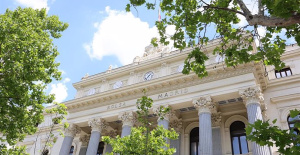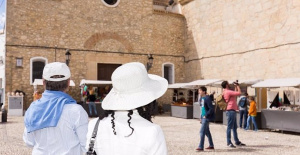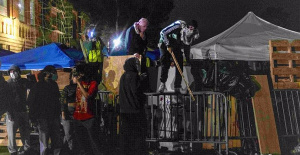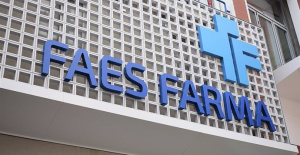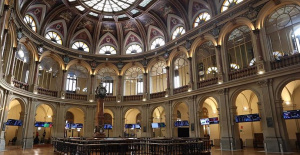Researchers from the University of Alicante are part of the initiative
ALICANTE, July 21. (EUROPEAN PRESS) -
Researchers from the University of Alicante are developing a tool based on Artificial Intelligence (AI) for transcription of medieval scores. They are doing so within the European project Repertorium (Researching and Encouraging the Promulgation of European Repertory through Technologies Operating on Records Interrelated Utilizing Machines), which aims to preserve Europe's musical heritage and create state-of-the-art sound processing technologies, including immersive audio ready for the metaverse.
The professor of the Department of Languages and Computer Systems Jorge Calvo leads the UA team responsible for the creation of an OMR (Optical Music Recognition, in its acronym in English) that will bring back to life more than 4,000 pieces of Gregorian chant, which have not seen the light of day for more than 1,000 years. In total, they will work with 400,000 images of ancient manuscripts.
The OMR allows extracting information from digitized manuscripts, such as the melody, lyrics, type of liturgical rite or position in the liturgical cycle. In the context of the Repertorium it is a great scientific challenge because the AI not only has to understand the symbols of musical notation but also recognize the text of the works and automatically interpret how it should be sung.
Once the computer is capable of processing sheet music images and understanding them, the content of the works can be transcribed efficiently and accurately into a digital score format, allowing the application of all kinds of digital technologies to carry out the objectives of the project, the academic institution explains in a statement.
The project began its journey last January and will run for three years. Repertorium is made up of a consortium whose members come from eight countries and is coordinated by the Escuela Politécnica Superior de Linares of the University of Jaén. Partners also include the University of Oxford, the Complutense Institute of Musical Sciences, the Hispanic Association for the Study of Gregorian Chant, the Polytechnic University of Milan, the University of Tampere, the creative marketing company VIST.CO from Hamburg, the UK developer Spork Digital, the French Association Musicologie Médiévale, the Lithuanian National Philharmonic Orchestra and the cultural technology developer Odratek.
The Department of Language and Computer Systems of the University of Alicante has the best experts in Optical Music Recognition in the world. "We are the world leaders in OMR," says Professor Calvo, who says that one of the challenges of this project is that OCR (Optical Character Recognition) will be applied at the same time so that the text and notes will be transcribed in order to establish the relationship between the two. The cataloged songs will be published in digital libraries to disseminate this content, until now accessible only to a small number of experts.
These 400,000 images come from the archive of the Musical Paleography Workshop of the Abbey of Solesmes (France). Once digitized, they will be stored in DIAMM, the open platform of the University of Oxford, specialized in cataloging images of ancient musical manuscripts. On the other hand, the information related to the cataloging (metadata) will be indexed in the portal of the Medieval Music Manuscripts Online Association (MMMO), accessible openly. Both systems will be interconnected with each other to avoid duplication, ensure consistency and facilitate the work of consultation.
The project will lay the technological foundations for the process of cataloging music archives using, among other things, Artificial Intelligence techniques, which will be made available, in open source, so that they can be applied to other historical music archives.
In addition, another aspect will focus on developing technologies that allow a completely immersive experience in classical music concerts, so that the user can interact with the orchestra for recreational or educational purposes. This technology will also be accessible to orchestras, so that the public can interact in immersive concerts through technology and virtual reality platforms, thus promoting the development of new streaming markets and attracting new audiences.
Repertorium will publicize the technologies developed in cycles of conferences and fairs, in addition to preparing educational material and a series of publications for dissemination. Likewise, in its final stage, the project will offer several concerts and an opera so that the user can experience all this technology in practice. Workshops will also be given in conservatories and music schools.

 Exploring Cardano: Inner Workings and Advantages of this Cryptocurrency
Exploring Cardano: Inner Workings and Advantages of this Cryptocurrency Seville.- Economy.- Innova.- STSA inaugurates its new painting and sealing hangar in San Pablo, for 18 million
Seville.- Economy.- Innova.- STSA inaugurates its new painting and sealing hangar in San Pablo, for 18 million Innova.- More than 300 volunteers join the Andalucía Compromiso Digital network in one month to facilitate access to ICT
Innova.- More than 300 volunteers join the Andalucía Compromiso Digital network in one month to facilitate access to ICT Innova.-AMP.- Ayesa acquires 51% of Sadiel, which will create new technological engineering products and expand markets
Innova.-AMP.- Ayesa acquires 51% of Sadiel, which will create new technological engineering products and expand markets A ball of light crosses Spain and Portugal
A ball of light crosses Spain and Portugal Prime Minister Fico is stabilized within gravity
Prime Minister Fico is stabilized within gravity Israel's Minister for the Diaspora considers Sánchez "responsible" for there being "more victims" in Gaza
Israel's Minister for the Diaspora considers Sánchez "responsible" for there being "more victims" in Gaza Barça strikes down Real to lift the Queen's Cup
Barça strikes down Real to lift the Queen's Cup How Blockchain in being used to shape the future
How Blockchain in being used to shape the future Not just BTC and ETH: Here Are Some More Interesting Coins Worth Focusing on
Not just BTC and ETH: Here Are Some More Interesting Coins Worth Focusing on The UA participates in the proposed Ramses mission to study the close passage of an asteroid to Earth
The UA participates in the proposed Ramses mission to study the close passage of an asteroid to Earth They develop a tool to end discrimination biases in AI
They develop a tool to end discrimination biases in AI A research group from the UA works on the development of healthy foods through AI
A research group from the UA works on the development of healthy foods through AI The Valencian researcher José Rafael Penadés, named 'fellow' of the British Royal Society
The Valencian researcher José Rafael Penadés, named 'fellow' of the British Royal Society A million people demonstrate in France against Macron's pension reform
A million people demonstrate in France against Macron's pension reform Russia launches several missiles against "critical infrastructure" in the city of Zaporizhia
Russia launches several missiles against "critical infrastructure" in the city of Zaporizhia A "procession" remembers the dead of the Calabria shipwreck as bodies continue to wash up on the shore
A "procession" remembers the dead of the Calabria shipwreck as bodies continue to wash up on the shore Prison sentences handed down for three prominent Hong Kong pro-democracy activists
Prison sentences handed down for three prominent Hong Kong pro-democracy activists ETH continues to leave trading platforms, Ethereum balance on exchanges lowest in 3 years
ETH continues to leave trading platforms, Ethereum balance on exchanges lowest in 3 years Investors invest $450 million in Consensys, Ethereum incubator now valued at $7 billion
Investors invest $450 million in Consensys, Ethereum incubator now valued at $7 billion Alchemy Integrates Ethereum L2 Product Starknet to Enhance Web3 Scalability at a Price 100x Lower Than L1 Fees
Alchemy Integrates Ethereum L2 Product Starknet to Enhance Web3 Scalability at a Price 100x Lower Than L1 Fees Mining Report: Bitcoin's Electricity Consumption Declines by 25% in Q1 2022
Mining Report: Bitcoin's Electricity Consumption Declines by 25% in Q1 2022 Oil-to-Bitcoin Mining Firm Crusoe Energy Systems Raised $505 Million
Oil-to-Bitcoin Mining Firm Crusoe Energy Systems Raised $505 Million Microbt reveals the latest Bitcoin mining rigs -- Machines produce up to 126 TH/s with custom 5nm chip design
Microbt reveals the latest Bitcoin mining rigs -- Machines produce up to 126 TH/s with custom 5nm chip design Bitcoin's Mining Difficulty Hits a Lifetime High, With More Than 90% of BTC Supply Issued
Bitcoin's Mining Difficulty Hits a Lifetime High, With More Than 90% of BTC Supply Issued The Biggest Movers are Near, EOS, and RUNE during Friday's Selloff
The Biggest Movers are Near, EOS, and RUNE during Friday's Selloff Global Markets Spooked by a Hawkish Fed and Covid, Stocks and Crypto Gain After Musk Buys Twitter
Global Markets Spooked by a Hawkish Fed and Covid, Stocks and Crypto Gain After Musk Buys Twitter Bitso to offset carbon emissions from the Trading Platform's ERC20, ETH, and BTC Transactions
Bitso to offset carbon emissions from the Trading Platform's ERC20, ETH, and BTC Transactions Draftkings Announces 2022 College Hoops NFT Selection for March Madness
Draftkings Announces 2022 College Hoops NFT Selection for March Madness











